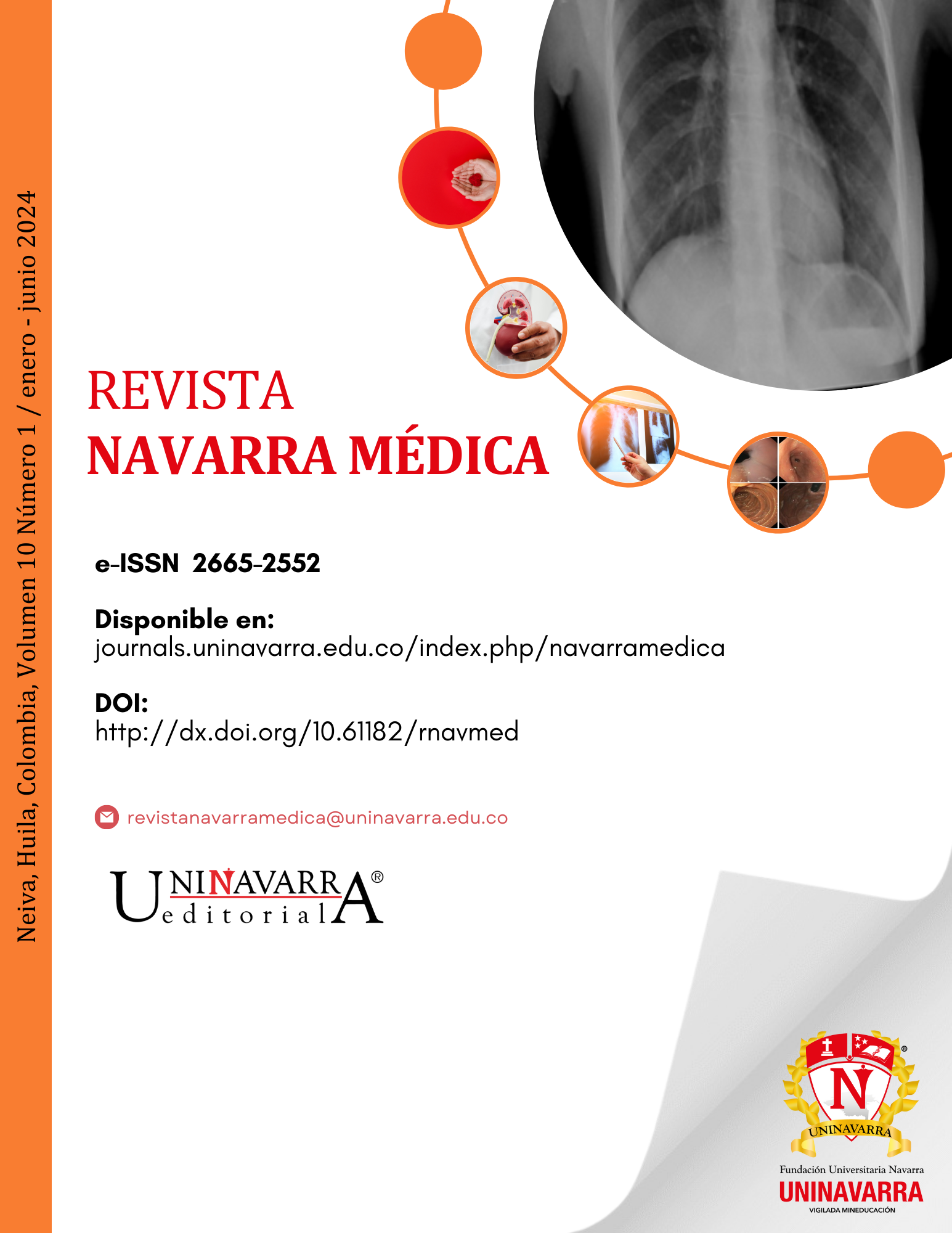Study on body composition and glycemic control in type 1 diabetes: insulin infusion therapy and continuous monitoring
DOI:
https://doi.org/10.61182/rnavmed.v10n1a4Keywords:
Diabetes Mellitus Type 1, Body composition, Glycemic control, Subcutaneous insulin infusion, HbA1c, Continuous glucose monitoringAbstract
Introduction: the increase in overweight and obesity represents an increasingly frequent challenge in people with type 1 diabetes mellitus (DM1). These conditions can negatively impact metabolic management, increasing the risk of associated complications.
Objective: to establish changes in body composition and glycemic control in patients with DM1 after three months of initiating therapy with continuous subcutaneous insulin infusion (CSII) plus CGM.
Materials and methods: the changes that occurred 3 months after initiating therapy with continuous subcutaneous insulin infusion (CSII) and continuous glucose monitoring (CGM) were analyzed in a group of patients (n=30). Parameters related to body composition (weight, height, body mass index, body fat percentage, muscle mass and visceral fat), glycemic control (HbA1c, coefficient of variation and time in range -TIR), as well as the amount of insulin used and carbohydrates consumed were evaluated.
Results: a total of 29 patients with DM1 completed three months of treatment with CSII and CGM. At the end of follow-up, a reduction in median HbA1c was observed from 7.5% (RIC 7 - 8.7) to 6.8% (RIC 6.7% - 7.1%) (p<0.0001). In addition, the TIR within the target range (70 - 180 mg/dl) increased from 70% (RIC 57% - 78%) to 79 % (RIC 68% - 85%) (p = 0.0080). There were no significant changes in body composition indicators or in the daily amount of insulin administered.
Conclusion: in patients with DM1 who received CSII and CGM for a period of three months, no relevant changes in body composition were identified. However, an improvement in glycemic control was evidenced, reflected in a decrease in HbA1c and an increase in time within the target glycemic range.
References
(1) Dabelea D, Mayer-Davis EJ, Saydah S, Imperatore G, Linder B, Divers J, et al. Prevalence of type 1 and type 2 diabetes among children and adolescents from 2001 to 2009. JAMA. 2014 May 7;311(17):1778–86. https://doi.org/10.1001/jama.2014.3201
(2) Rawshani A, Rawshani A, Franzén S, Eliasson B, Svensson AM, Miftaraj M, McGuire DK, Sattar N, Rosengren A, Gudbjörnsdottir S. Mortality and Cardiovascular Disease in Type 1 and Type 2 Diabetes. New England Journal of Medicine. 2017 Jul 20;377(3):300–1. https://doi.org/10.1056/nejmoa1608664
(3) Zimmet P, Alberti KGMM, Shaw J. Global and societal implications of the diabetes epidemic. Nature [Internet]. 2001 Dec 13 [cited 2022 Oct 15];414(6865):782–7. https://doi.org/10.1038/414782a
(4) Patterson CC, Harjutsalo V, Rosenbauer J, Neu A, Cinek O, Skrivarhaug T, et al. Trends and cyclical variation in the incidence of childhood type 1 diabetes in 26 European centres in the 25-year period 1989–2013: a multicentre prospective registration study. Diabetologia. 2019 Mar 1;62(3):408–17. https://doi.org/10.1007/s00125-018-4763-3
(5) Karvonen M. Incidence and trends of childhood Type 1 diabetes worldwide 1990-1999. Diabetic Medicine. 2006 Aug;23(8):857–66. https://doi.org/10.1111/j.1464-5491.2006.01925.x
(6) Aschner P. Epidemiología de la diabetes en Colombia. Avances en Diabetología. 2010 Apr;26(2):95–100. https://doi.org/10.1016/S1134-3230(10)62005-4
(7) Kjaer IGH, Kolle E, Hansen BH, Anderssen SA, Torstveit MK. Obesity prevalence in Norwegian adults assessed by body mass index, waist circumference and fat mass percentage. Clin Obes. 2015 Aug;5(4):211–8. https://doi.org/10.1111/cob.12100
(8) Flegal KM, Kruszon-Moran D, Carroll MD, Fryar CD, Ogden CL. Trends in obesity among adults in the United States, 2005 to 2014. JAMA. 2016 Jun 7;315(21):2284-91. https://doi.org/10.1001/jama.2016.6458
(9) Conway B, Miller RG, Costacou T, Fried L, Kelsey S, Evans RW, et al. Temporal patterns in overweight and obesity in Type 1 diabetes. Diabetic Medicine. 2010;27(4):398–404. https://doi.org/10.1111/j.1464-5491.2010.02956.x
(10) Flegal KM, Carroll MD, Ogden CL, Curtin LR. Prevalence and Trends in Obesity Among US Adults, 1999-2008 [Internet]. Available from: www.jamaarchivescme.com
(11) Wilkin TJ. The accelerator hypothesis: A review of the evidence for insulin resistance as the basis for type I as well as type II diabetes. International Journal of Obesity. 2009; 33(7): 716–26. https://doi.org/10.1038/ijo.2009.97
(12) Barone B, Rodacki M, Zajdenverg L, Almeida MH, Cabizuca CA, Barreto D, et al. Family history of type 2 diabetes is increased in patients with type 1 diabetes. Diabetes Res Clin Pract. 2008 Oct;82(1):e1-4. https://doi.org/10.1016/j.diabres.2008.03.015
(13) Knerr I, Wolf J, Reinehr T, Stachow R, Grabert M, Schober E, et al. The “accelerator hypothesis”: Relationship between weight, height, body mass index and age at diagnosis in a large cohort of 9,248 German and Austrian children with type 1 diabetes mellitus. Diabetologia. 2005 Dec;48(12):2501–4. https://doi.org/10.1007/s00125-005-0033-2
(14) Burr JF, Shephard RJ, Facsm D, Riddell MC. Physical Activity Series Physical activity in type 1 diabetes mellitus Assessing risks for physical activity clearance and prescription. 2012 May;58(5):533-5. https://pmc.ncbi.nlm.nih.gov/articles/PMC3352790/
(15) Taleb N, Haidar A, Messier V, Gingras V, Legault L, Rabasa-Lhoret R. Glucagon in artificial pancreas systems: Potential benefits and safety profile of future chronic use. Diabetes Obes Metab. 2017 Jan;19(1):13-23. https://doi.org/10.1111/dom.12789
(16) Colberg SR, Laan R, Dassau E, Kerr D. Physical activity and type 1 diabetes: Time for a rewire? J Diabetes Sci Technol. 2015 May 1;9(3):609–18. https://doi.org/10.1177/1932296814566231
(17) Francescato MP, Stel G, Stenner E, Geat M. Prolonged exercise in type 1 diabetes: Performance of a customizable algorithm to estimate the carbohydrate supplements to minimize glycemic imbalances. PLoS One. 2015 Apr 28;10(4). https://doi.org/10.1371/journal.pone.0125220
(18) Matteucci E, Giampietro O, Covolan V, Giustarini D, Fanti P, Rossi R. Insulin administration: Present strategies and future directions for a noninvasive (possibly more physiological) delivery. Drug Des Devel Ther. 2015 Jun 17;9:3109-18. https://doi.org/10.2147/dddt.s79322
(19) Edgerton DS, Lautz M, Scott M, Everett CA, Stettler KM, Neal DW, et al. Insulin’s direct effects on the liver dominate the control of hepatic glucose production. Journal of Clinical Investigation. 2006 Feb 1;116(2):521–7. https://doi.org/10.1172/jci27073
(20) Weight Gain Associated With Intensive Therapy in the Diabetes Contraband Complications Trial [Internet]. https://doi.org/10.2337/diacare.11.7.567
(21) Nansel TR, Lipsky LM, Iannotti RJ. Cross-sectional and longitudinal relationships of body mass index with glycemic control in children and adolescents with type 1 diabetes mellitus. Diabetes Res Clin Pract. 2013 Apr;100(1):126–32. https://doi.org/10.1016/j.diabres.2012.12.025
(22) Professional Practice Committee for the Standards of Medical Care in Diabetes—2016. Diabetes Care. 2016 Jan 1;39(Supplement_1):S107–8. https://doi.org/10.2337/dc16-s018
(23) Alderisio A, Bozzetto L, Franco L, Riccardi G, Rivellese AA, Annuzzi G. Long-term body weight trajectories and metabolic control in type 1 diabetes patients on insulin pump or multiple daily injections: A 10-year retrospective controlled study. Nutrition, Metabolism and Cardiovascular Diseases. 2019 Oct 1;29(10):1110–7. https://doi.org/10.1016/j.numecd.2019.06.008
(24) Kropff J, DeVries JH. Continuous Glucose Monitoring, Future Products, and Update on Worldwide Artificial Pancreas Projects. Diabetes Technol Ther. 2016 Feb 1;18(S2):S253–63. https://pubmed.ncbi.nlm.nih.gov/26784131/
(25) Forlenza GP, Buckingham B, Maahs DM. Progress in Diabetes Technology: Developments in Insulin Pumps, Continuous Glucose Monitors, and Progress towards the Artificial Pancreas. Journal of Pediatrics. 2016 Feb 1;169:13–20. https://doi.org/10.1016/j.jpeds.2015.10.015
(26) Garg SK, Weinzimer SA, Tamborlane W v., Buckingham BA, Bode BW, Bailey TS, et al. Glucose Outcomes with the In-Home Use of a Hybrid Closed-Loop Insulin Delivery System in Adolescents and Adults with Type 1 Diabetes. Diabetes Technol Ther. 2017 Mar 1;19(3):155–63. https://doi.org/10.1089/dia.2016.0421
(27) Mehta SN, Andersen HU, Abrahamson MJ, Wolpert HA, Hommel EE, McMullen W, et al. Changes in HbA1c and Weight Following Transition to Continuous Subcutaneous Insulin Infusion Therapy in Adults with Type 1 Diabetes. J Diabetes Sci Technol. 2017 Jan 1;11(1):83–6. https://doi.org/10.1177/1932296816658900
(28) Alderisio A, Bozzetto L, Franco L, Riccardi G, Rivellese AA, Annuzzi G. Long-term body weight trajectories and metabolic control in type 1 diabetes patients on insulin pump or multiple daily injections: A 10-year retrospective controlled study. Nutrition, Metabolism and Cardiovascular Diseases. 2019 Oct 1;29(10):1110–7. https://doi.org/10.1016/j.numecd.2019.06.008
(29) Prídavková D, Samoš M, Kazimierová I, Šutarík Ľ, Fraňová S, Galajda P, et al. Insulin Pump Therapy-Influence on Body Fat Redistribution, Skeletal Muscle Mass and Ghrelin, Leptin Changes in T1D Patients. Obes Facts. 2018 Dec 1;11(6):454–64. https://doi.org/10.1159/000493734
Downloads
Published
Issue
Section
License
Copyright (c) 2024 Carlos Javier Vizcaino Guerrero, Adriana Medina Orjuela, Diana Carolina Coral Coral, Julio Edil Benítez Montes, Carlos Hernán Calderón Franco, Amina Luz Ely Páez

This work is licensed under a Creative Commons Attribution-NonCommercial 4.0 International License.








